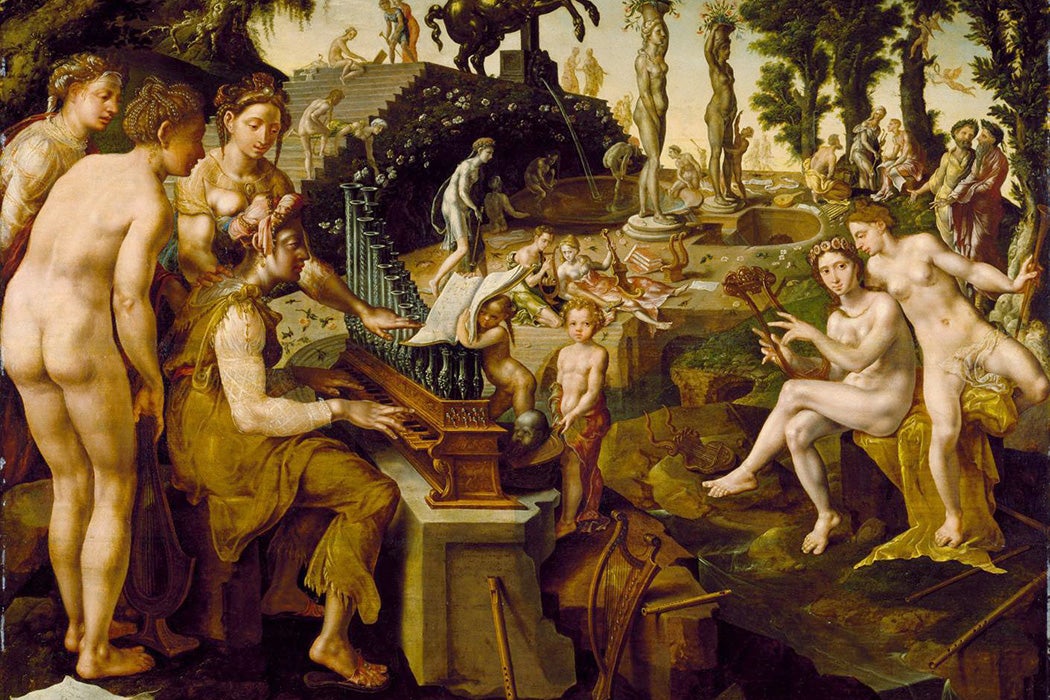In the beginning, there was just one, unnamed, muse. The blind bard Homer (a poet born around around 850 BC) invoked her with the words “Sing, daughter of Zeus” in the first lines of his epic poem, the Odyssey.
Then there were said to be three: Melete (practice), Mneme (memory) and Aoede (song), perhaps embodying the basic creative process of early humanity. Eventually, nine muses were identified, covering every branch of the arts, in the ancient Greek poet Hesiod’s introduction to Theogony, his epic poem about mythical stories and characters (circa 730–700BC). Hesiod, formerly an illiterate shepherd, claimed that he was inspired to write the poem when a beautiful goddess whispered the story in his ear.
There were muses specifically for comedy, tragedy and even erotica. The oldest was Calliope, mother of the legendary musician Orpheus. Euterpe was the muse of music. Urania guided the scientists. Terpsichore taught dance.
The muses promised fame and fortune to artists who followed them, but are rarely mentioned by name in the prologues and prefaces of artworks today.
A Timeline of the Muses
Originally characterized as singing and dancing goddesses guarding a sacred spring, evidence for the muses is found in writing by some of the earliest known authors.
Yet, the muses existed long before reading and writing. It was only later that they were conscripted as the mascots of writers, with some ancient mosaics showing pens and parchment superimposed on their original images. Following their assimilation from the oral tradition into cheerleaders of literacy, the muses are seen waving pens and quills, scrolls and manuscripts in ancient artworks.
Written storytelling about the muses started in the matriarchal period of prehistory, shifting to patriarchy in approximately 3000 BC, in Ovid’s story of the god Apollo fashioning himself the first laurel wreath. This crown of leaves, which supposedly signified his genius, is seen in the myth of Daphne, who turned into a laurel tree to escape Apollo’s unwanted advances.
Written by Ovid in Metamorphoses, this picturesque tale may have been a metaphor for the switch from female to male authority. Legend has it that Apollo prevented his muse priestess from brewing, imbibing or smoking laurel leaves, which have a mild narcotic property.
It wasn’t just fanciful poets in the muse’s congregation—philosophers kept the faith too. In approximately 370 BC, Socrates classed “possession” by the muses as a form of divine madness like drunkenness, eroticism or dreaming: “He who, having no touch of the muses’ madness in his soul, thinks that he will get into the temple by the help of art—he, I say, and his poetry are not admitted.”
English poet and soldier Robert Graves (1895–1985) agreed, writing in 1948 that his:
“Inspiration” was the breathing-in by the poet of fumes from an intoxicating cauldron, the Awen of the cauldron of Cerridwen, containing probably a mash of barley, acorns, honey, bull’s blood and such sacred herbs as ivy, hellebore and laurel as at Delphi.
Changing Times
These original practices of using drink or drugs to inspire art are still in use around the world today. The muses may hold a pen in one hand and a smoke, or steaming mug, in the other—herbal remedies continue to be efficacious for writer’s block.
In the Elizabethan period, when a poet’s relationship with the muses was perceived as directly proportionate to their success in romance, loving attention was paid to their invocation in rhythm and rhyme. But post-Enlightenment, it was no longer considered right for writers to invoke a supernatural mentor for literary endeavors. Modern men were influenced by reason and rationality, rather than a deity. Then it was more likely that a dead bard or scene from nature was deemed an appropriate source of inspiration.
Though writing remained a ritualistic practice, and its mechanisms sometimes mystical, the desk no longer doubled as an altar at which the author worshiped.
Weekly Newsletter
Yet writers still often claim “the muse is with me” at moments when the words flow magically. Her voice can be heard in the modern “Interval with Erato” by Scott Cairns (2015), which name checks the ancient overseer of love poetry:
That’s what I like best about you, Erato sighed in bed, that’s why you’ve become one of my favorites and why you will always be so.
For the most part, the muses are missed off the agenda by both the microscope-gazers and the navel-gazers, these days. However, Plato did insist in his dialogue Phaedrus (370 BC) that most people are eu amousoi (εὖ ἄμουσοι) an ancient Greek expression that means “happily without the muses”.
Contemporary theories of creativity do not often mention divine inspiration. We no longer like the idea that the best stories are given to a few fated writers by God, that great plots and characters are bestowed on favored authors by goddesses. But the answer to that common question all writers are asked—“where do you get your ideas from?”—still seems more mystic, less mathematic and as much supernatural as subconscious.![]()
This article is republished from The Conversation under a Creative Commons license. Read the original article.








